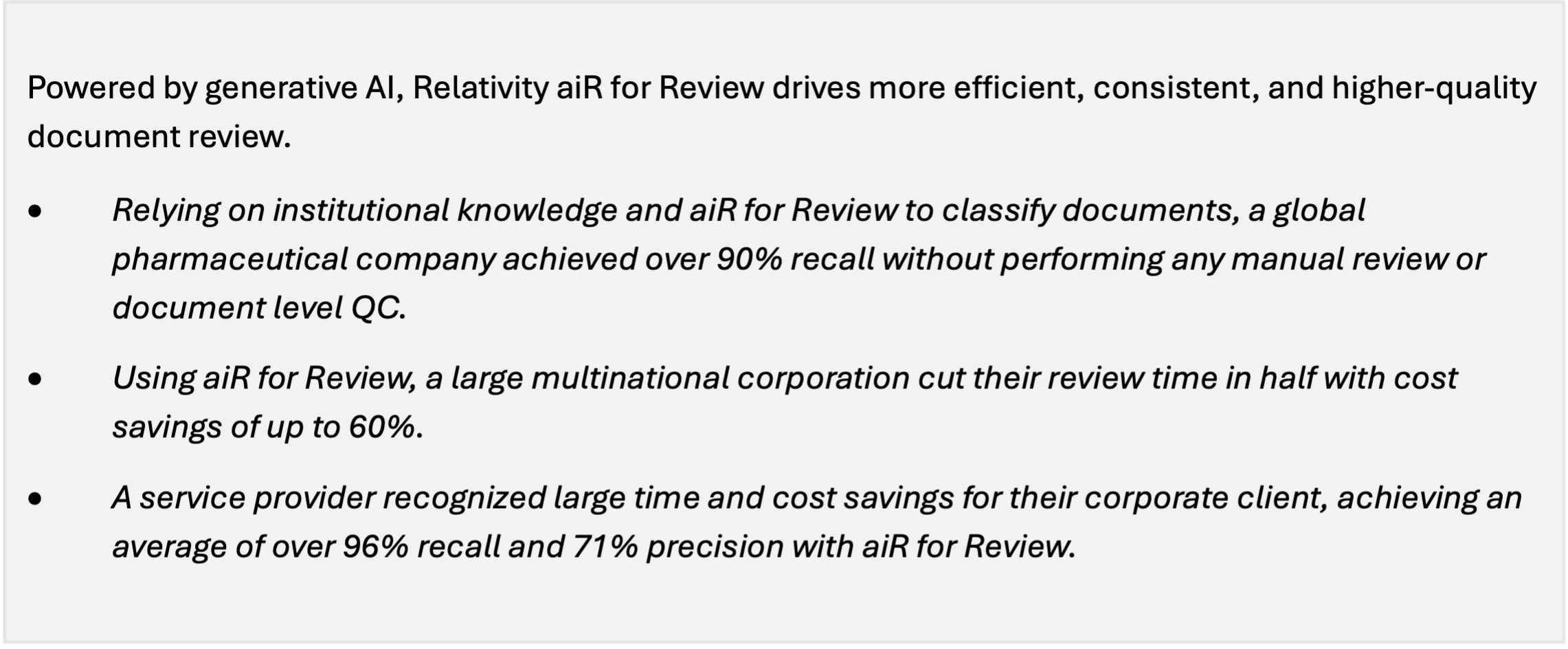Generative
AI
is
revolutionizing
the
legal
industry
by
driving
critical
efficiencies
in
long-established
processes.
Doing
more
with
less
has
historically
been
a
challenge
for
in-house
counsel,
and
teams
are
eager
for
new
solutions,
particularly
in
e-discovery.
As
documented
in
a
new
IDC
Research
Study
commissioned
by
Relativity,
Generative
AI
in
Legal
2024,
50%
of
respondents
have
reported
that
their
AI
use
has
increased
over
the
past
two
years
and
respondents
reported
that
48%
of
their
day-to-day
AI
use
involves
generative
AI.
Knowing
where
to
start
with
generative
AI
can
feel
overwhelming,
especially
with
so
many
potential
applications.
To
help
narrow
the
options
and
derive
the
greatest
value,
in-house
teams
need
to
prioritize
solutions
that
will
have
the
most
impact
on
how
they
work.
For
teams
ready
to
apply
generative
AI
directly
to
e-discovery,
first-pass
review
has
proven
a
great
area
to
start.
Why
First-Pass
Review
During
a
recent
industry
event,
in-house
e-discovery
leaders
highlighted
three
key
reasons
for
why
first-pass
review
is
an
ideal
starting
place:
-
Optimize
review
workflows:
Teams
can
determine
their
generative
AI
workflow
and
keep
human
reviewers
in
the
loop.
Generative
AI-powered
technology
can
be
used
for
first-pass
review,
followed
by
a
second
pass
by
human
reviewers
to
confirm
documents
are
responsive. -
Save
time
and
money:
Generative
AI
can
analyze
thousands
of
documents
per
hour,
quickly
identifying
the
most
relevant
content. -
Standardize
document
evaluation:
Generative
AI
provides
a
consistent
determination
every
time,
unlike
human
reviewers
who
might
code
the
same
document
differently.
It
doesn’t
get
exhausted
through
long
documents
and
performs
a
full
assessment
every
time.
In
the
end,
experimentation
is
key
to
learning
quickly
and
getting
the
most
out
of
generative
AI-
powered
solutions.
From
automating
routine
tasks
to
taking
on
parts
of
the
EDRM,
continuous
testing
and
refinement
finding
will
help
you
find
the
most
effective
use
case
for
your
organization.

Trust
But
Verify
As
with
any
new
technology
or
process
change,
corporate
legal
teams
should
approach
generative
AI
with
the
same
caution,
identifying
inherent
risks
and
verifying
outputs.
When
evaluating
the
results
of
generative
AI,
teams
can
depend
on
the
same
best
practice
metrics
used
in
e-discovery
for
the
last
20
years:
recall,
precision,
elusion
rate
and
more.
By
adhering
to
these
metrics
for
accuracy,
teams
can
easily
gauge
the
performance
of
their
prompt
input
and
compare
results
to
current
workflows.
Generative
AI
does
introduce
new
types
of
risks,
but
these
risks
can
be
mitigated
with
appropriate
technology
parameters.
For
example,
Relativity
addresses
the
risk
of
hallucinations
through
a
chain-of-thought
approach,
requiring
that
generative
AI
validate
its
citations
in
the
source
document
it
is
analyzing.
When
it
comes
to
security
and
privacy
with
generative
AI,
organizations
need
to
deploy
strategies
to
prevent
employee
misuse.
Public
models
like
ChatGPT
are
constantly
learning,
and
employees
can
easily
input
proprietary
data
into
prompts
that
become
part
of
the
training
data
set
for
future
outputs.
Relativity
At
Relativity,
generative
AI
solutions
are
built
with
privacy
and
security
at
their
core
using
a
secure
integration
with
Microsoft
Azure’s
OpenAI
services.
All
data
input
into
Relativity
aiR
for
Review
stays
within
the
confines
of
RelativityOne,
and
no
data
is
stored
or
retained
by
Azure
OpenAI.
Additionally,
all
AI
innovation
rests
upon
Relativity’s
AI
Principles,
which
guide
our
everyday
decision-making
to
ensure
we’re
creating
technology
that’s
clear,
fair,
and
gives
our
customers
the
utmost
control.
Starting
your
Journey
Like
any
journey,
the
beginning
is
the
hardest
part.
Here
are
some
tips
to
get
started:
-
Identify
effective
use
cases:
Determine
where
you
are
spending
the
most
resources
and
your
appetite
for
generative
AI
to
help
address
challenges.
For
ideas,
check
out
the
AI
Advantage
Webinar
Series
to
hear
from
your
peers. -
Recognize
the
opportunity:
Generative
AI
offers
a
unique
chance
to
differentiate
yourself
as
a
leader
and
set
your
company
apart
from
the
competition. Those
that
started
early
are
already
logging
many
successes
and
savings. -
Experiment
and
learn
fast:
The
more
you
use
your
models
and
train
them
on
your
data,
the
more
powerful
and
accurate
they
will
become
to
you.
Likewise,
the
faster
you
start
prompting,
the
faster
you
can
determine
what
prompts
deliver
the
best
results.
Most
importantly,
technology
companies
are
innovating
on
these
products
faster
than
ever
and
the
earlier
you
sign
on,
the
more
you
can
define
changes
to
products. -
Collaborate
for
success:
Partner
with
internal
and
external
teams
to
identify
avenues
for
enhanced
productivity.
For
example,
external
teams
can
use
generative
AI
to
save
you
money
on
billable
hours.
Or,
complete
jobs
in
a
fraction
of
the
time.
The
next
step
to
implementing
generative
AI
into
your
e-discovery
workflows
is
simple:
set
up
time
with
the
Relativity
team
to
find
the
right
solution
or
partner
for
your
business.

